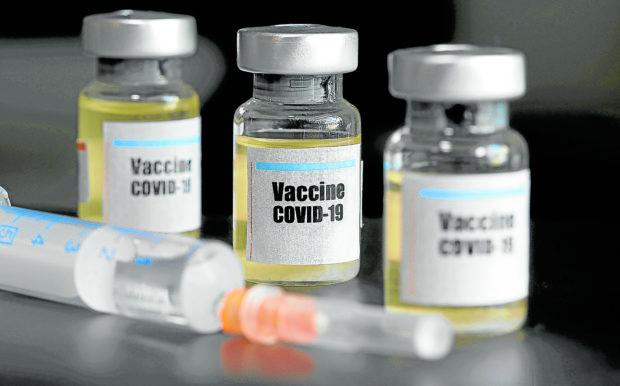MANILA, Philippines — With COVID-19 cases surging in cities and provinces outside the National Capital Region (NCR) Plus bubble, Cabinet Secretary and Inter-Agency Task Force for the Management of Emerging Infectious Diseases cochair Karlo Nograles on Tuesday said President Rodrigo Duterte has ordered the country’s vaccine distribution strategy “recalibrated,” with more doses given to areas under the modified enhanced community quarantine (MECQ).
“[The President] already agreed to make [those] areas with a high number of COVID [cases] a priority in the vaccine deployment,” Nograles said in a radio interview.
Placed under the more restrictive MECQ until the end of the month are Santiago City in Isabela, Cagayan, Apayao, Ifugao, Lucena City in Quezon, Bataan, Puerto Princesa City in Palawan, Naga City in Camarines Sur, Iloilo City, Iloilo province, Negros Oriental, Zamboanga City, Zamboanga Sibugay, Zamboanga del Sur, Zamboanga del Norte, Cagayan de Oro City in Misamis Oriental, Davao City, Butuan City, Agusan del Sur, and Dinagat Islands.
The country’s limited supply of COVID-19 vaccines was initially concentrated in the NCR, its six adjacent provinces, Metro Cebu, and Metro Davao in a bid to inoculate a bigger population at the soonest possible time.
Gyms, fitness centers
Also on Tuesday, presidential spokesperson Harry Roque said indoor sports facilities, indoor tourist attractions and venues for meetings, conferences and exhibitions may now reopen in Metro Manila and Bulacan, both of which President Duterte placed under general community quarantine (GCQ) “with restrictions” beginning today, Wednesday.
Roque said gyms and fitness centers may open with 20-percent capacity, which could be increased up to 30 percent if they secure the government’s safety seal. Other indoor sports courts are allowed at 30-percent capacity.
Also allowed to open with 30-percent capacity are venues for meetings, conferences and exhibitions, as well as indoor tourist attractions such as historical sites and museums, Roque said.
The venue capacity of salons and parlors, and outdoor tourist attractions has meanwhile been increased from 30 to 50 percent. It is now 40 percent for indoor dining.
Their venue capacity may be increased by 10 percent more if they secure the safety seal, with strict adherence to minimum public health standards, Roque said.
Churches and religious facilities are now allowed up to 30-percent capacity for wakes, weddings,
baptisms and all other activities. Local governments have discretion to increase this up to 50 percent.
Only people age 18 to 65 are allowed to go out of their residences, as are fully vaccinated seniors who must show proof.
Off-track betting stations, traditional cockfighting and cockpits, amusement parks, fairs, playgrounds and kiddie rides, recreation venues such as net cafes, billiards and arcades, and entertainment venues such as bars, concert halls and theaters shall remain closed.
“GCQ with heightened restrictions” remains for Laguna, Cavite and Rizal from June 16 to 30.
The Department of Health (DOH) said three regions were at high risk and 10 others at moderate risk of a surge that was experienced in March by Metro Manila, which is now classified as low risk.
High-risk regions
DOH chief epidemiologist Alethea De Guzman told a media briefing on Tuesday that the high-risk regions of Cagayan Valley, Caraga and Western Visayas lately registered an average daily attack rate (Adar) of 10.36, 9.27 and 8.11 per 100,000 population, respectively. Currently, the national Adar is 5.96 per 100,000 population.
At moderate risk are Davao, Northern Mindanao, Soccsksargen, Central Luzon, Eastern Visayas, Central Visayas, Ilocos, Bicol, the Cordillera Administrative Region and the Bangsamoro Autonomous Region in Muslim Mindanao.
“In the recent seven days, we are seeing increases in cases nationwide,” De Guzman said, adding that “the presence of the variants of concern was not the sole reason for this,” but that areas experiencing spikes in cases need to consistently implement public health protocols and swiftly detect and isolate infected persons and their close contacts.
Dead men walking
On Tuesday, the DOH recorded 5,389 new cases, bringing the total case count to 1,327,431. Sixteen laboratories did not submit their data.
The DOH said 6,667 have recovered, bringing total recoveries to 1,246,405. With 118 more deaths, including 65 who were previously tagged as recoveries, the total number of deaths stand at 22,963.
Of the 58,063 who are still battling the infection, including 304 who were previously reported as recoveries, 91.8 percent are mildly ill, 3.8 percent are asymptomatic, 1.3 percent are moderately ill, 1.8 percent severely ill and 1.3 percent are critically ill.
The DOH said 13.9 percent out of 30,472 who were tested were found positive for the virus.
